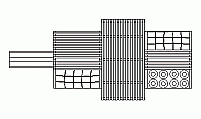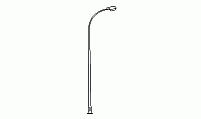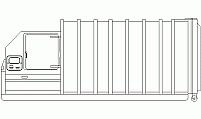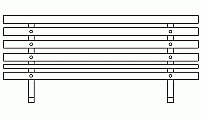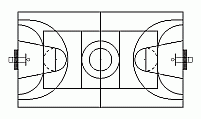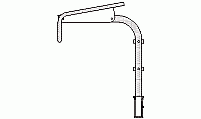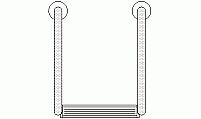CAD Blocks categories
 3D models
3D models home furniture
home furniture sanitary ware - bathrooms
sanitary ware - bathrooms professional equipment
professional equipment doors and windows
doors and windows people and animals
people and animals plants and trees
plants and trees vehicles - transports
vehicles - transports architectural details
architectural details mechanical - electrical
mechanical - electrical urban planning - civil works
urban planning - civil works safety health construction
safety health construction accessible design
accessible design drawing sheet
drawing sheet signals
signals construction machinery
construction machinery accessories and objects
accessories and objects maps and street maps
maps and street maps
Modern Bus Stop with Curved Glass Canopy in DWG Format

size: 8 kb
category: street furniture
related categories:
description: side view CAD block of a modern bus stop featuring a curved glass canopy, seating bench, and vertical lighting pole for enhanced nighttime functionality.
file extension: .dwg CAD - AutoCAD software
Comprehensive Details of Modern Bus Stop Structures
Detailed Design of the Bus Stop
The bus stop features a curved glass canopy supported by a robust metal structure, providing shelter for waiting passengers. The canopy's design ensures protection from the elements, accommodating up to three or four individuals comfortably. The integrated bench includes a plastic or wooden supplement for enhanced comfort during waiting times.
Adjacent to the shelter, a modern, vertically elongated lighting pole enhances functionality during nighttime hours, ensuring safety and visibility. The inclusion of human figures in the design aids in appreciating the structure's dimensions and spatial relationships, offering a comprehensive understanding of the bus stop's layout.
Standard Dimensions and Measurements
Standard bus stop shelters typically have a length of approximately 12 meters (39.37 feet), a width of at least 2 meters (6.56 feet), and a height around 3 meters (9.84 feet). These dimensions provide sufficient space for passenger comfort and accessibility, allowing multiple individuals to use the shelter simultaneously without overcrowding.
In the provided CAD block, the bus stop's canopy extends adequately to cover the seating area, ensuring protection from weather conditions. The bench is designed to accommodate multiple users, with dimensions that align with standard ergonomic requirements. The lighting pole's height is proportionate to the shelter, providing effective illumination without causing glare or discomfort to the passengers.
Construction and Integration Guidelines
- How is the glass canopy attached to the metal structure?
- The glass canopy is secured to the metal frame using high-strength brackets and fittings, ensuring stability and durability. The connections are designed to withstand various weather conditions and provide long-term service without compromising safety.
- What materials are recommended for the seating bench?
- The seating bench typically utilizes weather-resistant materials such as treated wood or high-density polyethylene (HDPE) plastic. These materials offer durability, low maintenance, and comfort for users, making them ideal for outdoor public furniture.
- How is the lighting integrated into the bus stop design?
- The lighting pole is strategically placed adjacent to the shelter, providing ample illumination for the waiting area. It is equipped with energy-efficient LED fixtures that offer bright, uniform light, enhancing safety and visibility during nighttime hours.
- Can the bus stop design be customized for different urban settings?
- Yes, the modular nature of the design allows for customization to suit various urban environments. Adjustments can be made to the canopy size, seating capacity, and lighting features to meet specific requirements and aesthetic preferences of different locales.
- What maintenance considerations are there for this bus stop design?
- Regular maintenance includes cleaning the glass canopy to remove dirt and debris, inspecting the metal structure for signs of corrosion, and ensuring the lighting fixtures are functioning correctly. Using durable materials minimizes the frequency and cost of maintenance activities.
Advantages of Modern Bus Stop Designs
Modern bus stop designs offer numerous benefits, including enhanced passenger comfort through weather protection and ergonomic seating. The use of durable materials ensures longevity and reduces maintenance costs, making them a cost-effective solution for urban infrastructure.
Additionally, integrated lighting improves safety and visibility during nighttime, encouraging public transit use at all hours. The aesthetic appeal of contemporary designs contributes positively to the urban landscape, promoting a cohesive and attractive public environment.
Evolution of Bus Stop Infrastructure
Bus stop infrastructure has evolved significantly over the years, transitioning from simple signposts to sophisticated shelters offering various amenities. Early designs focused solely on functionality, providing minimal protection from the elements. Over time, the incorporation of materials like glass and metal introduced durability and aesthetic appeal, making bus stops more user-friendly and visually pleasing in urban environments.
In different parts of the world, bus stop designs have adapted to local climates and cultural preferences. For instance, in Scandinavian countries, shelters often include heating elements to combat cold temperatures, while in tropical regions, designs may prioritize ventilation and shade. This evolution reflects a growing recognition of the importance of creating comfortable and functional spaces for public transit users, tailored to their specific environmental and cultural needs.










